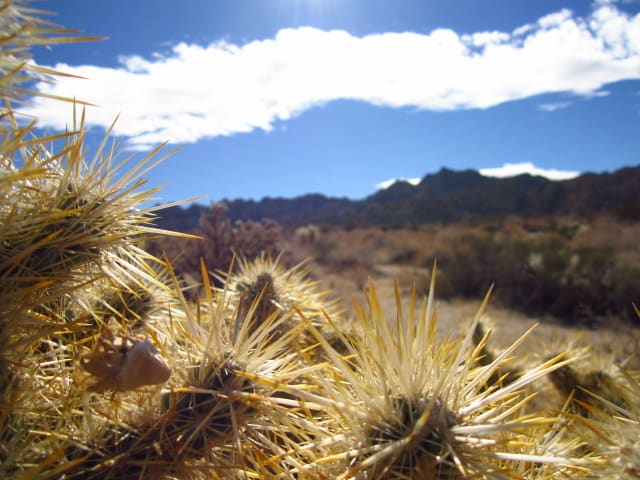
Some of my favorite memories of the great outdoors in 2012 include sunny days spent in Joshua Tree National Park last November. Having never been, I was amazed at the diversity of plants to be seen. Situated in both the Mojave and Colorado Deserts, the park has a multitude of cacti and shrubs as well as some junipers and oaks at higher elevations. The desert shrubs have really grown on me as, in addition to their varied appearances and the stunning habitats in which they are found, they also have excellent names. For example, Ocotillo, the common name for Fouquieria splendens, just rolls off the tongue. Even, Yucca brevifolia, Joshua Tree National Park’s namesake has a growth pattern that is tree-like at times and shrub-like at others.

While many photographers flock to the deserts in the springtime to catch the fleeting wildlfower bloom, flowering shrubs can be found in the desert even in mid-November. I found two such plants on my hike to 49 Palms Oasis. In a wash at the start of the trail I startled a bunch of Gambel’s quail while trying to get to some tall shrubs I mistook to be a type of sage, based on the gray-green leaves and reminiscent flower shape. Honey bees foraged for nectar toward the top of the plants as well as many small butterflies. After some internet searching I determined that it wasn’t a sage at all, but Hyptis emoryi, commonly called desert lavender.This shrub is native to the Southwest and belongs to the Mint Family, Lamiaceae. According to the Jepson Horticultural Database, desert lavender can reach up to 3 meters in height, is found in southeastern California as well as Arizona and northwest New Mexico, and has a flowering time of January through May. Why then did I see honey bees and butterflies visiting this shrub mid-November when most of the flowers were going to seed? Wikipedia notes that desert lavender is an aromatic attractor. It is likely that this particular location in the wash provided the right conditions to extend bloom time and that the flowers continued to attract pollinators even after peak bloom.

The second flowering plant I found at the end of 49 Palms Oasis Trail at the oasis itself. Epilobium canum, commonly called California fuchsia or hummingbird trumpet, blooms from June to December in Joshua Tree and has the growth pattern of a subshrub. This native subshrub belongs to the Onagraceae, the Evening Primrose family, and is found throughout the western states with the exception of Washington and Montana. According to the Jepson eFlora Glossary, a subshrub is a “plant with the proximal above-ground stems woody, the distal stems and twigs not woody (or less so) and dying back seasonally,” whereas a shrub is a “woody plant of relatively short maximum height, with generally many branches from the base.” See the difference?

Further confusing the definition of shrub is the fact that within the Cactaceae family, many species are classified as shrubs with the additional distinction of being stem succulents. If I’ve learned anything, it’s that I’ve only scratched the surface of plant identification. I’ll leave you with one last picture of a shrub (stem succulent) lifeform, the California barrel cactus, Ferocactus cylindraceus. Here’s to continuing education in 2013!
